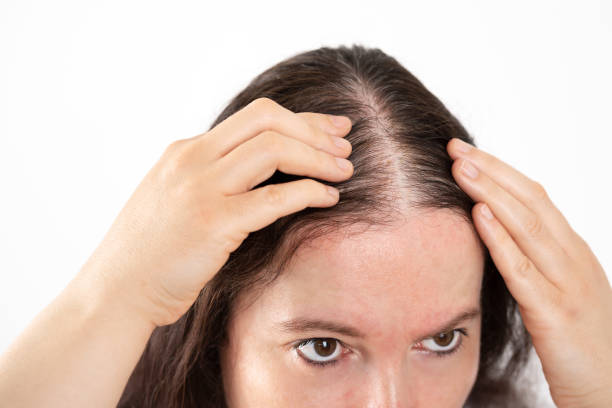
There are some struggles that are universal. It may feel like we all struggle with anxiety or motivation, or relationship issues. It may seem like there is a social media post or an online blog about these “common” mental health issues to be found everywhere. It is true that most people experience a lot of these issues at one time or another; there is a certain comfort in knowing that you are not the only person dealing with specific setbacks or difficulties.
So what happens when our mental health struggles feel rare or uncommon, such as hair-pulling, skin-picking, or nail-biting? What happens when you feel like the only one doing it? How do you know where to go, how to ask for help? You may be seeking Body-Focused Repetitive Behaviors (BFRB) therapy in Los Angeles if you have been compulsively pulling out your hair, otherwise known as trichotillomania. While trichotillomania is rare, you are not the only person who does it, which means that there is help available to help you cope with it!
What is Trichotillomania?
Trichotillomania is a psychological disorder characterized by the irresistible urge to pull out one’s hair. This can be hair anywhere on the body, including the scalp, eyebrows, eyelashes, arms, and more. It can significantly impact a person’s emotional well-being and self-esteem,

leading to difficulties in social interactions and daily functioning. Like many other mental health struggles, the impulse may become overwhelming and cause a lot of anxiety, followed by relief or pleasure after pulling out your hair. It can be accompanied by rituals, be exacerbated by stress, and cause issues in your private and public life (such as in your personal relationships or at work).
Trichotillomania is a complex condition with various underlying factors, including genetic predisposition, environmental influences, and neurological mechanisms. For some, the hair-pulling is deliberate and focused. For others, they don’t realize they’re doing it. While some people outside of trichotillomania may view it as a “bad habit,” it is actually a mental health disorder requiring and deserving of professional help and guidance.
Three Ways to Treat Trichotillomania
1) Let go of the Shame:

First things first, do not beat yourself up for your struggle! You do not have to feel embarrassed or less than for having trichotillomania. I know the idea of letting go of your shame may feel easier said than done, but this is where we are going to start. If you had any other chronic illness (and maybe you do), would you be hard on yourself about it? Hopefully, you would not! A mental illness is as much your “fault” as it would be if you had asthma. Unfortunately, even though we’ve come a long way in destigmatizing mental illness, it can be harder to open up about mental health struggles than other struggles we may face.
Letting go of shame doesn’t happen all at once. It is an ongoing process of adapting how you speak to yourself. It’s not about denying your frustration or deciding all of a sudden that Trichotillomania doesn’t impact you. Instead, it’s about treating yourself with kindness and compassion rather than self-loathing. Believe it or not, reacting to your negative thoughts with empathy and love helps you, even if it doesn’t change the behavior.
A common experience might be to think to yourself in terms of “should” statements: “I should be able to control myself,” or “I should be better at coping with this by now!” When those thoughts arise, showing yourself kindness looks like responding to the thought itself or to the idea of it. For example, if you get stuck in a headspace where you are talking to yourself a lot about what you “should” be doing or not doing, take a moment to validate the emotion you feel connected to that. “It is perfectly natural to impose unrealistic expectations on myself.” Then follow it up with a change of mindset: “I choose to be more productive with my thoughts and focus on what is in my control.”
When you do the work to let go of shame, you may begin to realize that it doesn’t start and end with you. If there are people around you who feed into your negative thoughts, you may have to take a look at those relationships. You are adding to your battle if you have anyone around you who invalidates or denigrates your struggle. For example, these might be people who echo, reinforce, or even instigate your “should” thoughts. “You should have grown out of this,” or, “There is no reason for this; you should be able to control yourself!” They may comment on missing hair, or on witnessed behaviors, in a way that undermines your confidence or embarrasses you in group settings. They might try to tell you that Trichotillomania is “just a bad habit” and not a mental illness; they might take it upon themselves to minimize your struggle.
Faced with these sorts of people, it’s up to you to determine what boundaries you can and will set. Sometimes, these may be coworkers with whom we have no choice but to spend time. Simple statements like, “I would prefer if we focused on work,” or, “That is my private business,” will hopefully do the trick; if not, you can look at escalating the issue to someone higher-up. If your social group is composed of friends and/or family members who aren’t supportive, that can be trickier because you care about maintaining those relationships. Advocate for yourself from a place of self-respect and mutual consideration. “I know you care about me and my health, but these comments don’t help me in my process.” If you feel comfortable telling someone you have professional care in place, do so: “My therapist is aware of this issue, and we are working on it together.” You may want to thank them for their interest and assume the best intentions, or tell them you don’t appreciate their sentiments. Whatever makes you feel the most safe and the most comfortable is what will work best for you.
2) Seek Therapy:
I know – how shocking for a therapy website blog to recommend therapy. But guess what? We believe in our therapy and its effectiveness. We also believe therapy must be one of the first steps you take when confronted with a need

change behavior. You are not supposed to “just stop” or figure this out on your own. Your inability to stop is not because you don’t have the “will” or keep making the wrong “choice”; it is because you are in need of specific help in order to overcome your mental illness. We offer specialized therapy for trichotillomania in Los Angeles because it is necessary; if you’ve tried to stop in the past and haven’t been able to, it wasn’t because there is something “wrong with you.”
To give you some preview of treating trichotillomania, it involves using the ComB (Comprehensive Behavioral) model, which is a behavior change framework that looks at five domains involving hair pulling: sensory, cognitive, affect, motor, and place. This model exists to help break down the complexity of this kind of behavior; therefore, therapy for BFRBs (Body-Focused Repetitive Behaviors) follows certain guidelines in order to make the most effective use of it. You may choose to attend therapy in person or online. Whatever situation allows you to be most open and honest is going to be what is best for you. There is no way to self-monitor and self-report productively if you are withholding information. This means that if you don’t have a private space from which to attend online therapy, you may benefit more from in-person. If traveling to an office creates anxiety, then attending from a safe space may be better.
To sum it up, the therapy has two parts: first, you have to engage in self-monitoring to gather information on your particular hair-pulling routines involving the above-mentioned five domains; then, you create an action plan that addresses the specifics. It is important to note that the ComB model should be used in conjunction with evidence-based therapeutic approaches like Habit Reversal Training and Cognitive-Behavioral Therapy to provide the most effective treatment for trichotillomania. Not only will therapy support you in your ComB steps but throughout the process of doing them. It can be taxing to take careful note of behaviors and actions that you don’t have positive associations with. A therapist can help you cope with other feelings that may arise, anxieties and/or worries that may or may not relate to your trichotillomania treatment, and perspective about your process that you may struggle to find.
Outside of methods that are specific to trichotillomania, therapy will give you an outlet for any and all other stressors in your life. Any anxieties or issues that can exacerbate your compulsions should be dealt with, regardless of how consistently you can manage your trichotillomania symptoms. Mental illnesses don’t exist in a vacuum; other mental health triggers and struggles impact them.
3) Mindfulness and Self-Care:

In the face of shame and embarrassment, our best weapon is to take care of ourselves. Unfortunately, this is also one of the harder times to do so. When we feel down about ourselves, it is harmful to reinforce those feelings by neglecting ourselves. This provides feedback, however unconsciously, that we are right to feel the way we do. Instead, when we feel down about ourselves in some way, we should behave as though we are proud and full of self-worth. This trains our brains to believe it, as our actions impact our thoughts, and vice versa. It is much harder to believe that you are worthy of love and happiness when treating yourself carelessly. Having a consistent self-care routine is health-supporting both mentally and physically.
This process requires mindfulness so that we can clue in when we are beginning to feel those negative thoughts emerge. Often, a hard time doesn’t come on all at once. There are usually signs and symptoms that we aren’t feeling our strongest or our most self-assured. Noticing that this shift is occurring can help you to stop your thoughts in their tracks. You might opt to change your actions, to lean into your basic needs (are you sleeping, eating, hydrating enough? Have you done an activity you enjoy recently?), and/or to treat yourself to some extra care. Mindfulness is not about noticing what is happening and then investing all our energy in analyzing and solving it. Instead, mindfulness helps us to take note of something without judgment in order to better show ourselves kindness and care.
In your struggles, you may resist being mindful and prefer to feel numb or detached. Disassociating may be something you talk about in your trichotillomania treatment. Grounding yourself in the present through various mindfulness techniques, such as utilizing your senses or repeating affirmations, can help you to stay present and therefore commence dealing with whatever has you feeling the need to detach.
Self-care looks different to everyone because everyone’s values are different. For some, self-care looks like time away from electronics; for others, it looks like a movie night. Some people like to spend their self-care time in quiet solitude, while others might enjoy a busy social event. Sometimes, we tell ourselves we can’t participate in the self-care routines we would like to because the financial investment isn’t feasible. In situations like this, try to determine if there is a way to have that self-care in your life, even if it’s not as often as you would prefer. For example, if you wish to go to the spa once per month but it would stress your budget in other areas you value, you might look for online deals and try to go once every three, four, six, or even twelve months. You might also look for ways to create a spa of your own, perhaps through taking long baths, doing face masks, or investing in a foot bath or back massager of your own. When deciding how to show yourself care, it is important for you to work out a way to do so. This trains you to put your needs high on your priority list, where they belong.
Trichotillomania is rare, and you probably feel alone in dealing with it. However, if you’ve ever wondered, “How many people have trichotillomania?” or, “Am I the only one who pulls out my hair?” you are most definitely not the only person who has dealt with or is

dealing with this. There are treatments and protocols established that can provide a way through for you. Not only that but working with a mental health professional will give you the tools to have conversations with the people in your life who may have questions or the people with whom you want to share your story. No matter how rare or specific your condition, there are tried and tested self-supportive measures that you can utilize to improve your overall mental health.
Trichtollamnia Therapy In Woodland Hills
It may feel like no one around you understand your struggle with Trichtollamnia or other BFRBs, but research shows that one out of 20 has it. In our practice here in Woodland Hills, our skilled therapists are here to work with you on Trichtollamnia Treatment to uncover all the underlying triggers to these strong urges and come up with a behavior plan that not only controls these urges but takes you back to living and enjoying your life.
Contact us today for your complimentary 20-minute phone consultation with our Client Care Coordinator.




